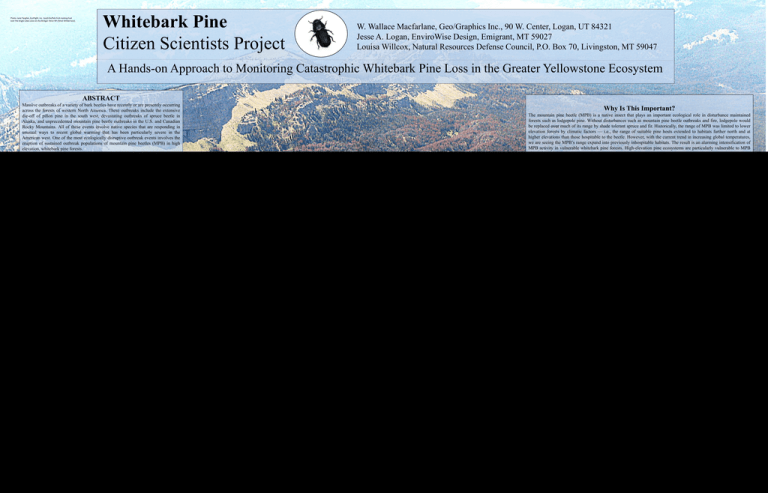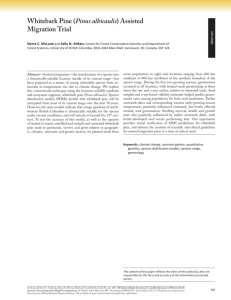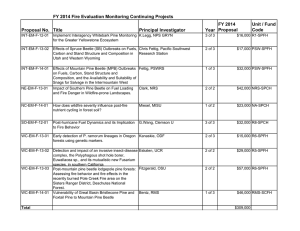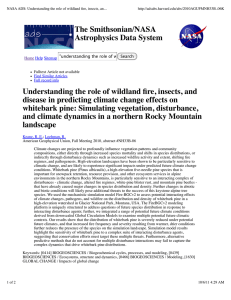Whitebark Pine
advertisement

Photo: Jane Pargiter, EcoFlight, Inc. South Buffalo Fork looking East over the Angle Lakes area on the Bridger-Teton NF (Teton Wilderness). Whitebark Pine Citizen Scientists Project W. Wallace Macfarlane, Geo/Graphics Inc., 90 W. Center, Logan, UT 84321 Jesse A. Logan, EnviroWise Design, Emigrant, MT 59027 Louisa Willcox, Natural Resources Defense Council, P.O. Box 70, Livingston, MT 59047 A Hands-on Approach to Monitoring Catastrophic Whitebark Pine Loss in the Greater Yellowstone Ecosystem ABSTRACT Massive outbreaks of a variety of bark beetles have recently or are presently occurring across the forests of western North America. These outbreaks include the extensive die-off of piñon pine in the south west, devastating outbreaks of spruce beetle in Alaska, and unprecedented mountain pine beetle outbreaks in the U.S. and Canadian Rocky Mountains. All of these events involve native species that are responding in unusual ways to recent global warming that has been particularly severe in the American west. One of the most ecologically disruptive outbreak events involves the eruption of sustained outbreak populations of mountain pine beetles (MPB) in high elevation, whitebark pine forests. Why Is This Important? The mountain pine beetle (MPB) is a native insect that plays an important ecological role in disturbance maintained forests such as lodgepole pine. Without disturbances such as mountain pine beetle outbreaks and fire, lodgepole would be replaced over much of its range by shade tolerant spruce and fir. Historically, the range of MPB was limited to lower elevation forests by climatic factors — i.e., the range of suitable pine hosts extended to habitats farther north and at higher elevations than those hospitable to the beetle. However, with the current trend in increasing global temperatures, we are seeing the MPB’s range expand into previously inhospitable habitats. The result is an alarming intensification of MPB activity in vulnerable whitebark pine forests. High-elevation pine ecosystems are particularly vulnerable to MPB outbreaks because they have not co-evolved in the same manner as lower-elevation forest ecosystems. In particular, whitebark pine is experiencing unprecedented MPB-caused mortality across a broad geographic range. The ecological implications are profound and widespread, as whitebark pine is the foundation species for alpine ecosystems of the northern U.S. Rocky Mountains. Whitebark pine is the foundation species for high-elevation forests of the U.S. northern Rocky Mountains, including the Greater Yellowstone Ecosystem (GYE). Loss of these forests holds important consequences concerning the ecological amenities they provide, from maintaining healthy watersheds to providing critical wildlife habitat. Although the losses that have already occurred in the GYE are substantial, no one knows their true extent. This lack of effective monitoring of bark beetle mortality in whitebark pine results from a combination of inherent limitations to the Forest Service Aerial Detection Survey (ADS) and insufficient funding. As a result, important policy decisions such as the delisting of the GYE grizzly bear population are being made based on inadequate and/or misleading information. This loss is hugely felt in the GYE. Consider the grizzly bear, one of the most notable species affected by increasing MPB outbreaks. By raiding red squirrel middens that contain vast quantities of whitebark pine cones, grizzly bears can efficiently obtain a source of high-quality food from the large, nutritious whitebark pine seeds. This food resource becomes available to the grizzly at a critical time—in the fall, just prior to entering hibernation. But if female grizzlies enter hibernation without sufficient nutritional reserves, they produce fewer cubs. In addition, human-caused mortality rates greatly increase if whitebark pine crops fail, as grizzlies are driven to forage in lower-elevation areas where more conflicts may occur with humans. In response to the lack of effective monitoring of whitebark pine mortality — specifically, mortality resulting from unprecedented MPB activity — a group of concerned citizens has organized to provide reliable, on-the-ground accounting of the extent and severity of mortality. In this poster we provide background information on the ecological and societal events that led to formation of this Citizen Scientists initiative, as well as the information structure and techniques we have devised that integrate Google Groups, Google Documents, and Google Earth along with ESRI GIS software for effective implementation. Although catastrophic loss of whitebark pine in the GYE has already occurred, no one knows its true extent. The principle measure of bark beetle activity is the USDA Forest Service's annual Aerial Detection Survey (ADS). But unfortunately, the ADS does not typically survey designated Wilderness Areas and National Parks — and Wilderness Areas and Parks comprise nearly 1/3 of the GYE. The distribution of whitebark pine is even more skewed, with almost 2/3 of whitebark pine in either Wilderness or Parks. Truly effective monitoring will require a combination of in-field observations, satellite imagery, computer simulations of risk, ground truthing in selected areas, and sequential documentation of key sites. It is in these latter two capacities that Citizen Scientists will play a critical role. With respect to mountain pine beetle and whitebark pine, nothing like what we see occurring today has been observed in recorded history or exists in the disturbance legacy of this long-lived species. If warming continues unabated, the foundation species of alpine forests over much of the Greater Yellowstone Ecosystem could become functionally extinct within the next 7 to 10 years, with potentially grave consequences. Who We Are and What We Do The Whitebark Pine Citizen Scientists Project (WBP Citizen Scientists) is a loosely organized group of citizens who are deeply concerned about the future of one of the last great intact American ecosystem, the Greater Yellowstone. In particular, we are interested in documenting whitebark pine mortality resulting from widespread mountain pine beetle outbreaks that are occurring across this charismatic landscape. Whitebark pine is a foundation species for high elevation forests of the Northern Rockies that helps build entire ecosystems; the ecological amenities provided by white bark pine ecosystems are far-reaching, ranging from maintaining healthy watersheds to providing critical habitat for elk, bears, birds, squirrels, and other wildlife. Citizen science is a term used to describe a project in which a network of volunteers, many of whom may have no formal scientific training, perform research-related tasks such as making field observations. Specifically, the WBP Citizen Scientist’s role is to report and/or document mountain pine beetle activity and infestation in whitebark pine within the Greater Yellowstone Ecosystem. We also envision that the Citizen Scientist Google Group will provide a forum for the exchange of observations, ideas, and concerns regarding whitebark pine in the Greater Yellowstone. How the Program Works Not everyone is in the position to participate in on-the-ground observation, but everyone has expertise (ranging from mathematical modeling to GIS to MPB ecology) that is invaluable to our collective enterprise. We anticipate the citizen scientist’s primary role to be the contribution of observational field data, but we also hope for him or her to be a part of an ongoing dialogue aimed at fostering the best possible monitoring and evaluation of the MPB’s role in the GYE. Our program uses Google Groups, Google Documents, and Google Earth along with ESRI GIS software to effectively monitor whitebark pine in this critical ecosystem (see diagram to left). The program relies on ―citizen scientists‖— volunteers who record their field observations regarding the impact of MBP on the GYE. We have received generous funding from the Natural Resources Defense Council to develop and manage this program. Data Recording Form Data can be entered as hard copy and sent to Geo/Graphics by U.S. mail for entry, or directly over the WWW via Google Forms in Digital format From Photograph to Digital Polygon Photograph of a Category 5 outbreak located near Avalanche Peak, Yellowstone Park Google Earth Polygon of the Cat. 5 area in the photograph The Greater Yellowstone Ecosystem The Greater Yellowstone Ecosystem is a BIG place— somewhere around 20 million acres. It can be difficult to wrap your mind around an area this large, with its complex orographic weather patterns that differentially affect weather, climate, and mountain pine beetle population dynamics. In order to try and come to grips with the GYE’s complexity, we have chosen to break down the ecosystem by the major mountain ranges that comprise the whitebark pine habitat of the GYE, focusing on the 13 ranges Tom Turiano describes in Select Peaks of Greater Yellowstone as well as the Tobacco Root, Gravelly, and Centennial ranges. We will use these 16 ranges as the organizational paradigm for weather analysis and description of mountain pine beetle impacts on whitebark ecosystems. Mountain Pine Beetle Outbreak Categories Category 0 – No Unusual MPB Activity Category 1 – Occasional spots of killed trees Category 2 – Multiple spots/years Category 3 – Multiple spots that have coalesced Category 4 – The ―Sea of Red‖ Stage Category 5 – Residual forest of dead trees






